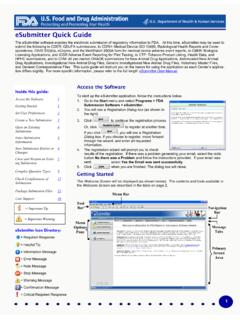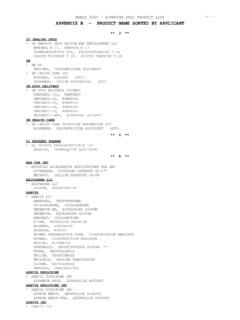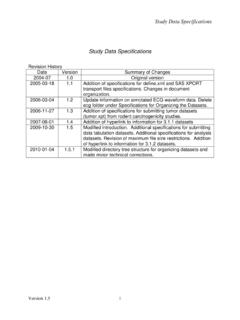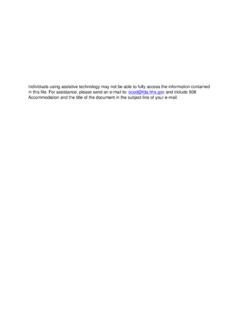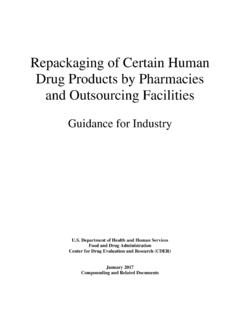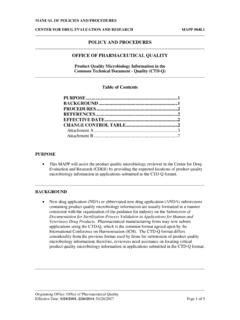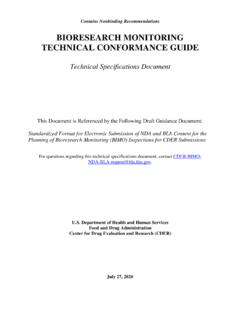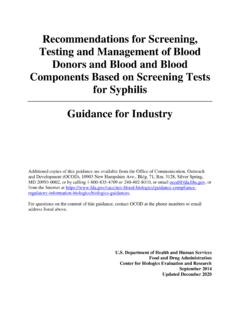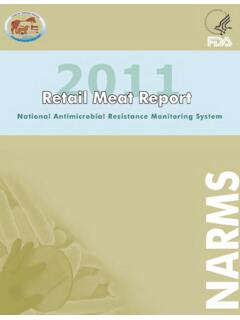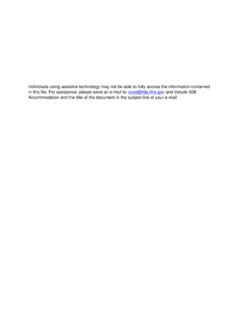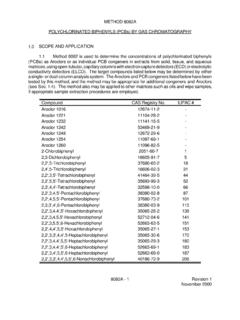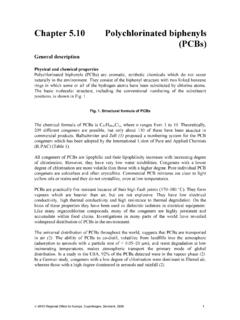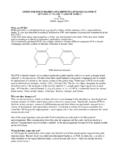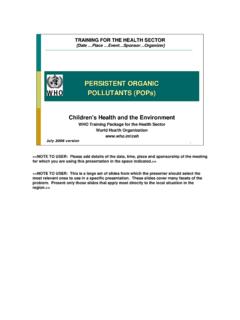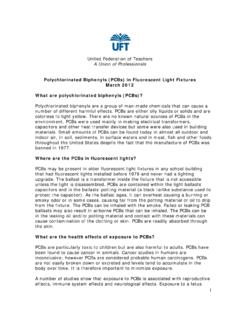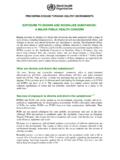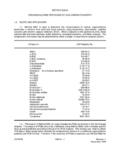Transcription of CHAPTER 9: Environmental Chemical Contaminants and ...
1 CHAPTER 9: Environmental Chemical Contaminants and pesticides This guidance represents the food and drug administration s (FDA s) current thinking on this topic. It does not create or confer any rights for or on any person and does not operate to bind FDA or the public. You can use an alternative approach if the approach satisfies the requirements of the applicable statutes and regulations. If you want to discuss an alternative approach, contact the FDA staff responsible for implementing this guidance. If you cannot identify the appropriate FDA staff, call the telephone number listed on the title page of this guidance. UNDERSTAND THE POTENTIAL HAZARD. Environmental Chemical Contaminants and pesticides in fish pose a potential human health hazard. Fish can be harvested from waters that are contaminated by varying amounts of industrial chemicals, including heavy metals and pesticides . These Contaminants may accumulate in fish at levels that can cause human health problems ( , carcinogenic and mutagenic effects).
2 The hazard is most commonly associated with exposure over a prolonged period of time (chronic exposure). Illnesses related to a single exposure (one meal) are very rare. Concern for these Contaminants primarily focuses on fish harvested from aquaculture ponds, freshwater bodies, estuaries, and near-shore coastal waters ( , areas subject to shoreside contaminant discharges), rather than from the open ocean. Environmental chemicals and pesticides may also accumulate in aquacultured fish through contaminated feed ingredients ( , pesticides in oil-containing feed ingredients derived from near-shore bait fish). Although some pesticides have not been produced or used in the United States for many years ( , dichloro-diphenyl-trichloroethane (DDT) and polychlorinated biphenyls (PCBs)), many are very persistent and tend to accumulate in soil and sediments. Once pesticides are introduced into the environment, they may travel beyond their point of application or discharge. Certain pesticides are applied directly to the water in aquaculture ponds to control weeds and algae and to eliminate fish and invertebrates.
3 These products can be used legally only if they are registered with the Environmental Protection Agency (US EPA) and used according to conditions described on the label (40 CFR 180 and the Guide to drug , Vaccine, and Pesticide Use in Aquaculture, the Federal Joint Subcommittee on Aquaculture ( jsa/wgqaap/ )). Many Contaminants accumulate in the edible fatty tissues of fish. Concentrations of these Contaminants can vary considerably in individual fish of the same species from the same location, depending on factors such as their fat content, size, age, and gender. In the case of components or extracts of whole fish ( , dietary supplements, dietary ingredients, and flavors), the component or extract may contain higher or lower concentrations of Environmental Chemical Contaminants and pesticides than the whole fish from which it was derived. For example, organochlorine Contaminants , such as PCBs, are oil soluble. When producing fish oil and fish meal, any PCBs present will become more concentrated in the oil fraction and less concentrated in the water fraction, as compared with the levels in the whole fish.
4 Control of Chemical Contaminants Federal tolerances and action levels are established for some of the most toxic and persistent Contaminants that can be found in fish. These levels are listed in Table 9-1. State, tribal, local, or foreign authorities may use the federal tolerances or action levels to decide whether to issue local advisories to consumers recommending limits on consumption of all or certain species of locally harvested fish (some of which may be commercially important) or to close waters for commercial harvesting of all or certain species of fish. CHAPTER 9: Environmental Chemical Contaminants and pesticides 155 In the case of molluscan shellfish, state, tribal, territorial and foreign government agencies, called shellfish control authorities, consider the degree of Chemical contamination as part of their classification of harvesting waters. As a result of these classifications, molluscan shellfish harvesting is allowed from some waters and not from others.
5 Shellfish control authorities then exercise control over the molluscan shellfish harvesters to ensure that harvesting takes place only when and where it has been permitted. In this context, molluscan shellfish include oysters, clams, mussels, and scallops. Other significant elements of shellfish control authorities efforts to control the harvesting of molluscan shellfish include requirements that (1) containers of in-shell molluscan shellfish (shellstock) bear a tag that identifies the type and quantity of shellfish, the harvester, harvest location, and the date of harvest (21 CFR (c)); (2) molluscan shellfish harvesters be licensed (note that licensing may not be required in all jurisdictions); (3) processors that ship, reship, shuck, or repack molluscan shellfish be certified; and (4) containers of shucked molluscan shellfish bear a label with the processor s name, address, and certification number. Processors of seafood components and extracts may choose to control Environmental Chemical Contaminants and pesticides at receipt ( , by screening raw materials).
6 If Contaminants in the raw material are present at unacceptable levels, processors may reject the product or choose to implement refining steps that reduce the Contaminants to acceptable levels in the finished product. These steps may include distillation, absorption, and steam deodorization. You should validate the effectiveness of these refining steps at reducing Environmental and Chemical Contaminants to an acceptable level and include appropriate controls in your Hazard Analysis Critical Control Point (HACCP) plan. No further information on these control measures is provided in this guidance document. Tolerance and action levels Table 9-1, Environmental Chemical Contaminants and pesticides Tolerance and Action Levels, lists the tolerance and action levels that have been established for Environmental Chemical Contaminants and pesticides in the edible portion of fish (wet weight). CHAPTER 9: Environmental Chemical Contaminants and pesticides 156 CHAPTER 9: Environmental Chemical Contaminants and pesticides 157 TABLE 9-1 Environmental Chemical Contaminants AND pesticides TOLERANCE AND ACTION LEVELS Tolerance Levels DELETERIOUS SUBSTANCE LEVEL IN EDIBLE TISSUE food COMMODITY REFERENCE PCBs 2 ppm All fish 21 CFR Carbaryl ppm Oysters 40 CFR Diquat 2 ppm Fish 40 CFR Diquat 20 ppm Shellfish 40 CFR Diuron and its metabolites 2 ppm Farm-raised, freshwater finfish 40 CFR Endothall and its monomethyl ester ppm All fish 40 CFR Fluridone ppm Finfish and crayfish 40 CFR Glyphosate ppm Fish 40 CFR Glyphosate 3 ppm Shellfish 40 CFR 2,4-D ppm Fish 40 CFR 2,4-D 1 ppm Shellfish 40 CFR Action Levels DELETERIOUS SUBSTANCE LEVEL IN EDIBLE TISSUE food COMMODITY REFERENCE Aldrin and dieldrin1 ppm All fish Compliance Policy Guide, Sec.
7 Benzene hexachloride ppm Frog legs Compliance Policy Guide, Sec. Chlordane ppm All fish Compliance Policy Guide, Sec. Chlordecone2 ppm All fish Compliance Policy Guide, Sec. Chlordecone2 ppm Crabmeat Compliance Policy Guide, Sec. DDT, TDE, and DDE3 5 ppm All fish Compliance Policy Guide, Sec. Methylmercury4 1 ppm All fish Compliance Policy Guide, Sec. Heptachlor and Heptachlorepoxide5 ppm All fish Compliance Policy Guide, Sec. Mirex ppm All fish Compliance Policy Guide, Sec. 1. The action level for aldrin and dieldrin is for residues of the pesticides individually or in combination. However, in calculating a total, amounts of aldrin or dieldrin found at below ppm are not counted. 2. Previously listed as Kepone, the trade name of chlordecone. 3. The action level for DDT, TDE, and DDE is for residues of the pesticides individually or in combination. However, in calculating a total, amounts of DDT, TDE, and DDE found below ppm are not counted.
8 4. See CHAPTER 10 for additional information. 5. The action level for heptachlor and heptachlor epoxide is for the pesticides individually or in combination. However, in calculating a total, amounts of heptachlor and heptachlor epoxide found below ppm are not counted. DETERMINE WHETHER THE POTENTIAL HAZARD IS SIGNIFICANT. The following guidance will assist you in determining whether Environmental Chemical Contaminants and pesticides are a significant hazard at a processing step: 1. Is it reasonably likely that unsafe levels of Environmental Chemical Contaminants or pesticides will be introduced at this processing step ( , do such Contaminants and pesticides come in on the raw material)? Tables 3-2 and 3-3 ( CHAPTER 3) identify the species of fish for which Environmental Chemical Contaminants and pesticides are a potential hazard. Under ordinary circumstances, it would be reasonably likely to expect that, without proper controls, unsafe levels of Environmental Chemical Contaminants and pesticides could enter the process at the receiving step from those species.
9 However, there may be circumstances that would allow you to conclude that it is not reasonably likely for unsafe levels of Environmental Chemical Contaminants and pesticides to occur in fish harvested from your area. You should be guided by the historical occurrence of Environmental Contaminants and pesticides , at levels above established tolerance and action levels, in fish from the area in which your fish are caught. This information may be available from federal, state, tribal, territorial, local, or foreign health or Environmental authorities in the area where your fish are caught. If you are receiving fish, other than molluscan shellfish, from another processor, you would not need to identify Environmental Chemical Contaminants and pesticides as a significant hazard. This hazard should have been fully controlled by the primary (first) processor. 2. Can unsafe levels of Environmental Chemical Contaminants and pesticides that were introduced earlier be eliminated or reduced to an acceptable level at this processing step?
10 Environmental Chemical Contaminants and pesticides should be considered a significant hazard at any processing step where a preventive measure is or can be used to eliminate the hazard or to reduce the likelihood of its occurrence to an acceptable level. Preventive measures for Environmental Chemical Contaminants and pesticides can include: For wild-caught fish other than molluscan shellfish: Making sure that incoming fish have not been harvested from waters that are closed to commercial harvest because of concentrations of Environmental Chemical Contaminants or pesticides exceeding the federal tolerance or action levels; Making sure that incoming fish have not been harvested (for commercial purposes) from the same waters that are under a consumption advisory by a state, tribal, territorial, local, or foreign regulatory authority based on a determination by the authority that fish harvested from these waters are reasonably likely to contain Contaminants above the federal tolerance or action levels.
